The compact CPC (Cell Processing Center) is comprised of five preparation rooms for advanced cell therapy and regenerative medicine to fulfill patient requirements.
Download pdf
As a pioneer that introduced CPC facility
The Center for Transfusion Medicine and Cell Therapy in Tokyo Medical and Dental University, Medical Hospital is working on cell therapy and regenerative medicine
in order to support and regenerate dysfunctional tissues and organs. The university established the Cell Processing Center (CPC) in 2002 for cell therapy and regenerative medicine.
The pioneering facility at the time that introduced CPC was established by Professor Tomohiro Morio, a former center chief. The center had three cell preparation rooms and one depressurized room in space of 100m2 which was designed and constructed by Sanyo Electric, the PHCbi predecessor.
After this, CPCs were required to conform to the structural design standards outlined in the Act to Ensure the Safety of Regenerative Medicine which was implemented in 2013. With the start of several research and clinical trial projects concerning cell therapy and regenerative medicine within the university, the construction of a new CPC was planned.
The new CPC was designed and constructed by Panasonic Healthcare, also the predecessor of PHCbi that had designed and constructed the previous center, continuing the good relationship from the Sanyo Electric days with support for possible malfunctions that was very highly evaluated.
The new CPC completed in 2014 comprises five cell preparation rooms in the same 100m2 space, achieving a compact and highly productive work environment. In addition, minimizing cross contamination risk through the definition of movement lines and rooms designed with a chamber pressure difference of 15Pa are also major features.
Currently, in the five cell preparation rooms, there are five projects related to the following research, clinical trials and therapies ongoing at the same time.
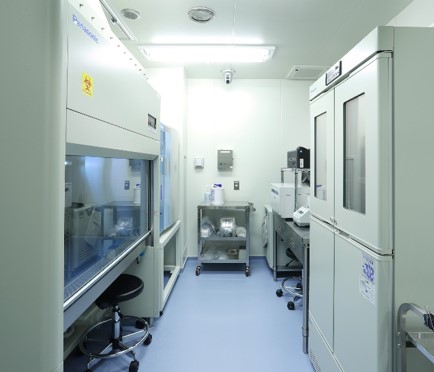
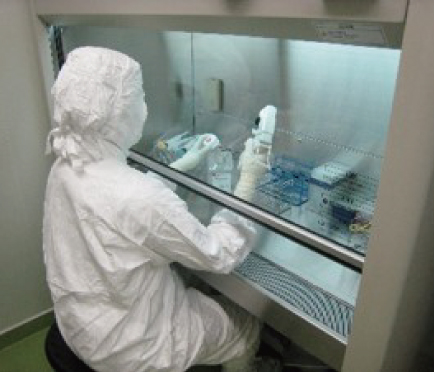
Cell Preparation Room 1 (Center for Stem Cell and Regenerative Medicine /Gastrointestinal Department)
Digestive tract regenerative therapy is being developed here. A small tissue sample is taken from patients suffering from inflammatory bowel disease (ulcerative colitis or Crohn's disease), using an endoscope to culture the stem cells included in the tissue as intestinal epithelial organoid outside the body.
After this step, the material is transplanted into a difficult-to-treat ulcer using an endoscope again for the treatment.
(Professor Mamoru Watanabe, chief researcher)

Cell Preparation Room 2 (Center for Transfusion Medicine and Cell Therapy / Blood Transfusion group)
Hematology and pediatric departments perform allogenic stem cell transplantation including unrelated settings through Japan Marrow Donor Program and Cord Blood Bank, and autologous peripheral stem cell transplantation.
In order to achieve safe and effective transplantation, research on stem cell harvest, preserving cells and post-transplantation complications are conducted to enable clinical applications.
(Michiko Kajiwara, Junior Associate Professor/ Vise Director)
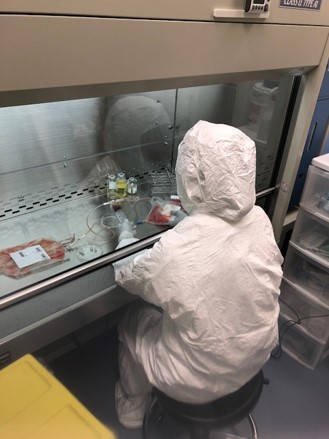
Cell Preparation Room 3 (Immune therapeutics)
Therapeutic vaccine for adult T-cell leukemia (ATL) is developed here. ATL is a poor prognosis malignant tumor caused by the human T-cell leukemia virus type I. It has been found that the cytotoxic T lymphocyte (CTL) to virus protein Tax has an anti-tumor effect. Clinical trials of dendritic cell vaccine are conducted in ATL patients by using Tax peptide at the CTL epitopes as antigen.
(Professor Mari Kannagi, Responsible researcher/Developer)
Cell Preparation Room 4 (Pediatrics)
Multiple virus-specific T-cell therapy for treatment-resistant infections is developed here.
After a hematopoietic cell transplantation, patients lapse into an immunodeficiency state until immunological reconstitution is achieved, and suffer from various viral infections such as Adenovirus, BK virus, EB virus, Cytomegalovirus, and Human herpes virus 6. At present, there are no effective treatments, and in many cases the disease becomes severe, so we have started a clinical trial with multiple virus-specific T-cell production for these 5 viruses using a method that can prepare the production within a period of 2 weeks.
(Professor Tomohiro Morio, Chief Researcher)
Cell Preparation Room 5 (Center for Stem Cell and Regenerative Medicine / Orthopedics)
Physician-led clinical trials are conducted to preserve the meniscus through meniscal repair to the meniscal damage that requires meniscus removal and trans-planting synovium-derived stem cells. In addition, clinical research is conducted to investigate whether knee osteoarthritis deterioration can be controlled by injecting the joint with synovial cells on a regular basis.
(Professor Ichiro Sekiya, Chief Researcher)
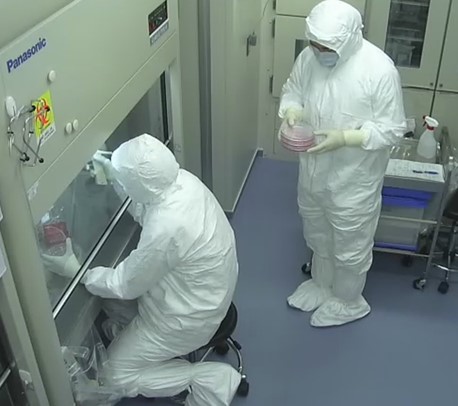
Introducing highly reliable, safe devices to handle the precious cells of patients.
The pharmaceutical refrigerators and biosafety cabinets used in the five cell preparation rooms and ultra-low temperature freezers (-150˚C/-80˚C) used in the cell refrigeration/preservation rooms and supply rooms are also PHCbi products. These products have an excellent reputation among project personnel as they are easy to use without requiring difficult manuals or complex operation.
Ultra-low temperature freezers employ the “dual cooling system” and incorporate two compressors to eliminate malfunction risk.
“Device malfunctioning can destroy precious cells used in treating patients and compromise research and clinical trial results. The word “sample” may sound somewhat casual, but samples are valuable assets and very important to patients and us.
The cell therapy and regenerative medicine we have been working on are the light of hope to patients. Physicians and researchers are therefore strongly motivated to achieve success in their tasks. They require maximum reliability and safety for the devices they relay on to store cells.
(Professor Ichiro Sekiya, Director of the Center)
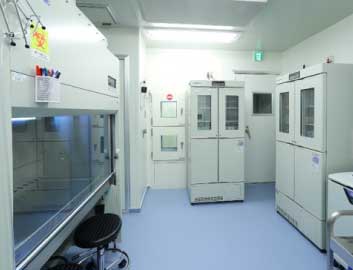
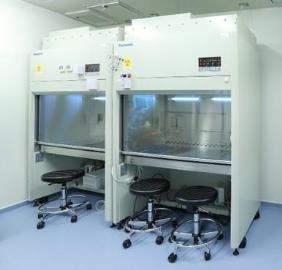

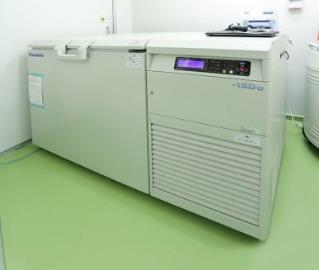
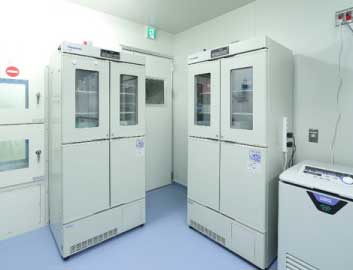
Preparing an environment that allows researchers to concentrate on research through the use of monitoring systems and cameras.
In order to achieve stable operation of not only a single device but the entire CPC as well, the facility is fully equipped with monitoring systems and surveillance camera systems. Even with careful attention, risk of contamination cannot be en-tirely eliminated. To minimize risk, the cleanness, room pressure and temperature in the preparation room as well as the chamber temperature and error status of all devices in the facility connected by cable with the interface board, are monitored 24/7 and work conditions also photographed.
The monitoring system immediately generates an alarm when an abnormality occurs and sends an email to staffs. “There had been a case where the CO2 incubator door was not closed completely and allowed the temperature to decrease. I was notified of the error by alarm, and entered the room to securely close the door and so prevented a serious problem.” (Technical staff)
An advantage of the monitoring system allows history data to be traced back. If there is a malfunction in a refrigerator, checking the change in chamber tempera-ture from the time the malfunction occurs to when the alarm sounds allows technical staffs take appropriate post-accident actions for the stored items.
“Thanks to the monitoring system, technical staff can concentrate on important work without worrying about the cell preparation room and devices.”
(Professor Ichiro Sekiya, Director of the Center)
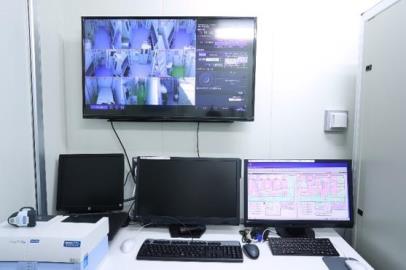

Continuing to work with precision, dealing with patients on an individual basis and society in good faith
Currently in the center’s CPC, each of the five project teams have exclusive use of one cell preparation room for their research. Should the number of cases dealing with cell therapy and regenerative medicine increase, it is expected that other project teams will also want to use the facility so it is necessary to establish a new facility operation method.
“At present, one cell preparation room is used exclusively by one team. However, in the future, there may be a case where one preparation room is used by one team and after cleaning is complete, it is used by another team. What is most important, however, is controlling the cleanness, room pressure and temperature in the facility to secure the environment required for cell preparation work. In order to achieve this goal, we and PHCbi as a whole want to build a partnership, one that would allow us to work sincerely and with precision, taking the viewpoint of patients and society, not just from the perspective of a customer and manufacturer.”
(Ichiro Sekiya, Director of the Center)
Product delivered
- Pharmaceutical refrigerator MPR-414F-PJ x 6
- Medical freezer (-40℃) MDF-U443-PJ x 1
- Ultra-low temperature freezer (-80℃) MDF-U400VX-PJ x 1
- Ultra-low temperature freezer (-150℃) MDF-C2156VAN-PJ x 1
- Laboratory autoclave MLS-3751-PJ x 4
- Biosafety cabinet MHE-132AJ-PJ x 5
- Biosafety cabinet MHE-130AB3-PJ x 1
Delivered to
Tokyo Medical and Dental University, Medical Hospital
1-5-45 Yushima, Bunkyo-ku, Tokyo, Japan
http://www.tmd.ac.jp/medhospital/english/